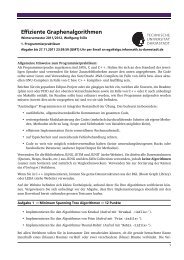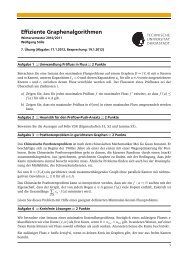Sentence and Expression Level Annotation of Opinions in User ...
Sentence and Expression Level Annotation of Opinions in User ...
Sentence and Expression Level Annotation of Opinions in User ...
You also want an ePaper? Increase the reach of your titles
YUMPU automatically turns print PDFs into web optimized ePapers that Google loves.
<strong>and</strong> provid<strong>in</strong>g anaphoric resolutions <strong>in</strong> discourse.<br />
We present an annotation scheme which fulfills<br />
the mentioned requirements, an <strong>in</strong>ter-annotator<br />
agreement study, <strong>and</strong> discuss our observations.<br />
The rest <strong>of</strong> this paper is structured as follows:<br />
Section 2 presents the related work. In Sections<br />
3, we describe the annotation scheme. Section 4<br />
presents the data <strong>and</strong> the annotation study, while<br />
Section 5 summarizes the ma<strong>in</strong> conclusions.<br />
2 Previous Op<strong>in</strong>ion Annotated Corpora<br />
2.1 Newspaper Articles <strong>and</strong> Meet<strong>in</strong>g Dialogs<br />
Most prom<strong>in</strong>ent work concern<strong>in</strong>g the expression<br />
level annotation <strong>of</strong> op<strong>in</strong>ions is the Multi-<br />
Perspective Question Answer<strong>in</strong>g (MPQA) corpus 2<br />
(Wiebe et al., 2005). It was extended several times<br />
over the last years, either by add<strong>in</strong>g new documents<br />
or annotat<strong>in</strong>g new types <strong>of</strong> op<strong>in</strong>ion related<br />
<strong>in</strong>formation (Wilson <strong>and</strong> Wiebe, 2005; Stoyanov<br />
<strong>and</strong> Cardie, 2008; Wilson, 2008b). The MPQA<br />
annotation scheme builds upon the private state<br />
notion (Quirk et al., 1985) which describes mental<br />
states <strong>in</strong>clud<strong>in</strong>g op<strong>in</strong>ions, emotions, speculations<br />
<strong>and</strong> beliefs among others. The annotation<br />
scheme strives to represent the private states <strong>in</strong><br />
terms <strong>of</strong> their functional components (i.e. experiencer<br />
hold<strong>in</strong>g an attitude towards a target). It<br />
consists <strong>of</strong> frames (direct subjective, expressive<br />
subjective element, objective speech event, agent,<br />
attitude, <strong>and</strong> target frames) with slots represent<strong>in</strong>g<br />
various attributes <strong>and</strong> properties (e.g.<strong>in</strong>tensity,<br />
nested source) <strong>of</strong> the private states.<br />
Wilson (2008a) adapts <strong>and</strong> extends the concepts<br />
from the MPQA scheme to annotate subjective<br />
content <strong>in</strong> meet<strong>in</strong>gs (AMI corpus), <strong>and</strong> creates the<br />
AMIDA scheme. Besides subjective utterances,<br />
the AMIDA scheme conta<strong>in</strong>s objective polar utterances<br />
which annotates evaluations without express<strong>in</strong>g<br />
explicit op<strong>in</strong>ion expressions.<br />
Somasundaran et al. (2008) proposes op<strong>in</strong>ion<br />
frames for represent<strong>in</strong>g discourse level associations<br />
<strong>in</strong> meet<strong>in</strong>g dialogs. The annotation scheme<br />
focuses on two types <strong>of</strong> op<strong>in</strong>ions, sentiment <strong>and</strong><br />
argu<strong>in</strong>g. It annotates the op<strong>in</strong>ion expression <strong>and</strong><br />
target spans. The l<strong>in</strong>k <strong>and</strong> l<strong>in</strong>k type attributes associate<br />
the target with other targets <strong>in</strong> the discourse<br />
through same or alternative relations. The op<strong>in</strong>ion<br />
frames are built based on the l<strong>in</strong>ks between targets.<br />
Somasundaran et al. (2008) show that op<strong>in</strong>ion<br />
frames enable a coherent <strong>in</strong>terpretation <strong>of</strong> the<br />
2 http://www.cs.pitt.edu/mpqa/<br />
op<strong>in</strong>ions <strong>in</strong> discourse <strong>and</strong> discover implicit evaluations<br />
through l<strong>in</strong>k transitivity.<br />
Similar to Somasundaran et al. (2008), Asher<br />
et al. (2008) performs discourse level analysis <strong>of</strong><br />
op<strong>in</strong>ions. They propose a scheme which first identifies<br />
<strong>and</strong> assigns categories to the op<strong>in</strong>ion segments<br />
as report<strong>in</strong>g, judgment, advice, or sentiment;<br />
<strong>and</strong> then l<strong>in</strong>ks the op<strong>in</strong>ion segments with<br />
each other via rhetorical relations <strong>in</strong>clud<strong>in</strong>g contrast,<br />
correction, support, result, or cont<strong>in</strong>uation.<br />
However, <strong>in</strong> contrast to our scheme <strong>and</strong> other<br />
schemes, <strong>in</strong>stead <strong>of</strong> mark<strong>in</strong>g expression boundaries<br />
without any restriction they annotate an op<strong>in</strong>ion<br />
segment only if it conta<strong>in</strong>s an op<strong>in</strong>ion word<br />
from their lexicon, or if it has a rhetorical relation<br />
to another op<strong>in</strong>ion segment.<br />
2.2 <strong>User</strong>-generated Discourse<br />
The two annotated corpora <strong>of</strong> user-generated content<br />
<strong>and</strong> their correspond<strong>in</strong>g annotation schemes<br />
are far less complex. Hu & Liu (2004) present<br />
a dataset <strong>of</strong> customer reviews for consumer electronics<br />
crawled from amazon.com. The follow<strong>in</strong>g<br />
example shows two annotations taken from the<br />
corpus <strong>of</strong> Hu & Liu (2004):<br />
camera[+2]##This is my first digital camera <strong>and</strong> what a toy<br />
it is...<br />
size[+2][u]##it is small enough to fit easily <strong>in</strong> a coat pocket<br />
or purse.<br />
The corpus provides only target <strong>and</strong> polarity annotations,<br />
<strong>and</strong> do not conta<strong>in</strong> op<strong>in</strong>ion expression or<br />
op<strong>in</strong>ion modifier annotations which lead to these<br />
polarity scores. The annotation scheme allows the<br />
annotation <strong>of</strong> implicit features (<strong>in</strong>dicated with the<br />
the attribute [u]). Implicit features are not resolved<br />
to any actual product feature <strong>in</strong>stances <strong>in</strong><br />
discourse. In fact, the actual positions <strong>of</strong> the product<br />
features (or any anaphoric references to them)<br />
are not explicitly marked <strong>in</strong> the discourse, i.e, it is<br />
unclear to which mention <strong>of</strong> the feature the op<strong>in</strong>ion<br />
refers to.<br />
In their paper on movie review m<strong>in</strong><strong>in</strong>g <strong>and</strong> summarization,<br />
Zhuang et al. (2006) <strong>in</strong>troduce an annotated<br />
corpus <strong>of</strong> movie reviews from the Internet<br />
Movie Database. The corpus is annotated regard<strong>in</strong>g<br />
movie features <strong>and</strong> correspond<strong>in</strong>g op<strong>in</strong>ions.<br />
The follow<strong>in</strong>g example shows an annotated sentence:<br />
〈<strong>Sentence</strong>〉I have never encountered a movie whose<br />
support<strong>in</strong>g cast was so perfectly realized.〈FO<br />
Fword=“support<strong>in</strong>g cast” Ftype=“PAC” Oword=“perfect”<br />
Otype=“PRO”/〉〈/<strong>Sentence</strong>〉








